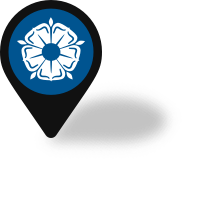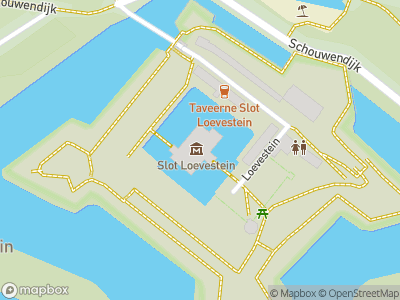Loevestein castle holds a very strategic position. Not only is it where the Maas and Waal rivers meet, but it is also the border between the provinces of Gelderland, Brabant and South Holland. The castle was the ideal place to keep a close eye on river traffic, and up until the last century, the area around the floodgates had served a military function. This significant location has been a guarantee for an eventful past.
Medieval castle
The name Loevestein, Loef – stein, means the stone house of Loef, which refers to Dirc Loef van Horne, the man who commissioned the castle in around 1357. The freebooter Loef van Horne used the castle as the headquarters for co-ordinated raids on the surrounding area. He levied illegal tolls on the river as well activities that were frowned upon by the counts of Holland.
The counts of Holland commandeered the castle and installed one of their own governors, Bruijsten van Herwijnen, who proved just as untrustworthy as Loef van Horne. Van Herwijnen was only interested in making himself rich and the counts of Holland were forced to attack. In the end, Loevestein Castle was conquered by its own troops.
State prison
In the years that followed, Loevestein Castle continued to be a bone of contention: firstly between the people of Holland, then between the people of Brabant, and then the people of Guelders. During the Eighty Years´ War, the Spaniards fought the Dutch State Army for possession of the castle and it eventually fell into the hands of the Dutch Republic. At this point in history, the castle was turned into a state prison for the detention of political prisoners.
Perhaps the most famous prisoner was Hugo Grotius (Hugo de Groot), a jurist of the Dutch Republic who laid the foundations for international law. Grotius was sentenced to life imprisonment, but he did not agree. With the aid of his wife and an empty book chest, he managed to escape.
New Dutch Waterline
In 1815, King William I decided to construct the New Dutch Waterline: an extension of the old Hollandic Waterline, running east beyond the city of Utrecht. The Waterline consisted of a line of forts and fortified towns that ran from the IJsselmeer Lake (formely known as the Zuiderzee) to National Park De Biesbosch.
The forts were responsible for controlling the river water and were capable of inundating the surrounding countryside to form a defensive barrier. Loevestein Castle, along with its neighbouring fortifications, became an important link in this defence system. Loevestein retained its military status until 1951.


 Voor kinderen
Voor kinderen














